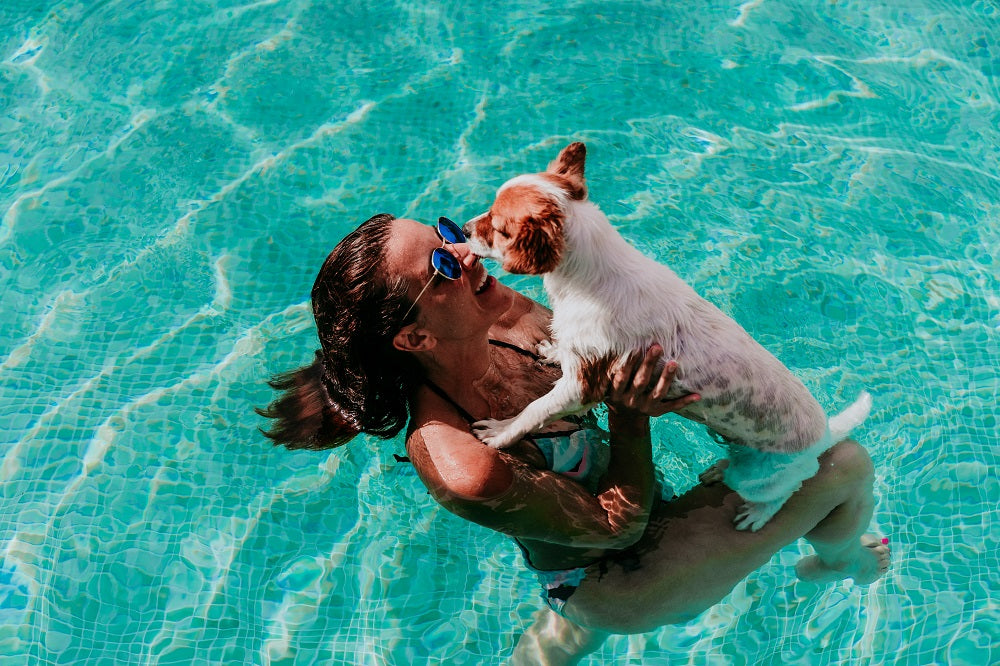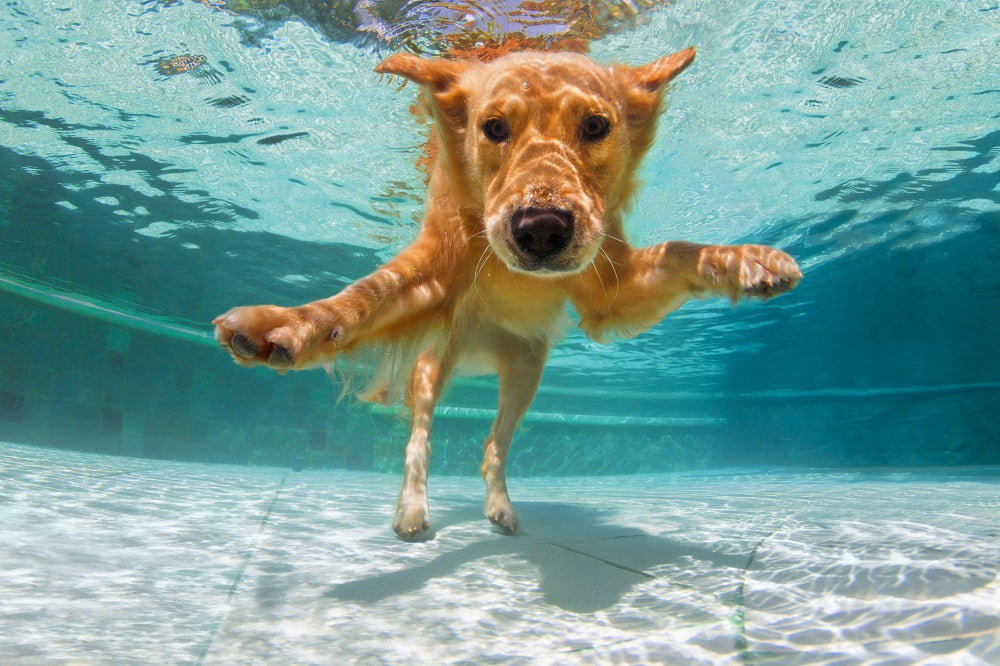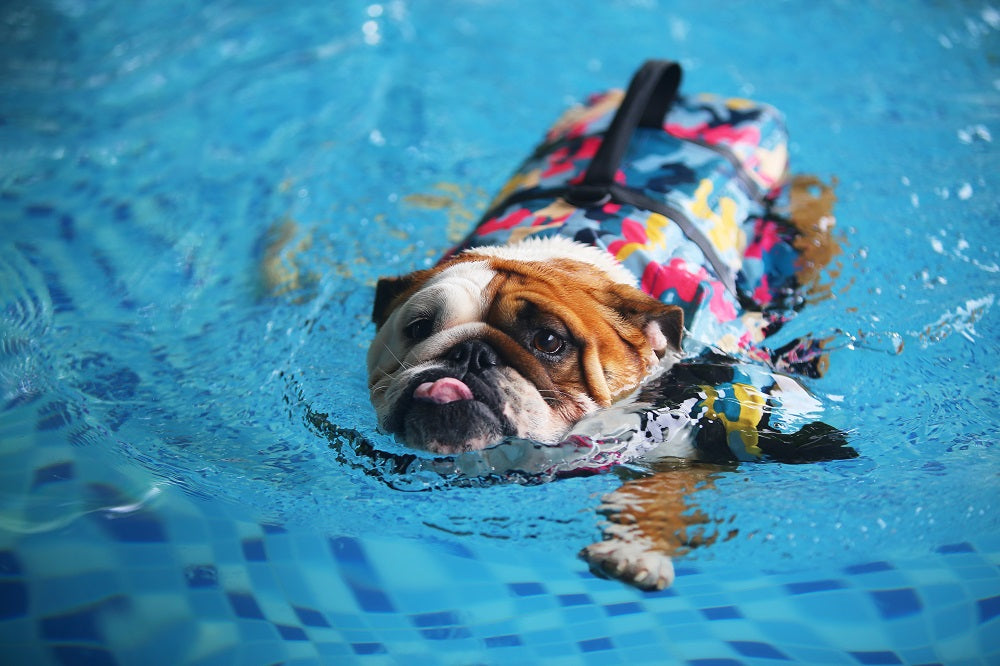Summertime means pool time, and while you’re busy splashing and having a blast, it’s essential not to forget about our furry friends! At BARK, pool safety for dogs is a topic close to our hearts because we know how much you care about your pets. After reading this article, we’ll understand the importance of pool safety, pool hazards, and pet CPR.
Importance of Swimming Pool Safety for Dogs
Swimming can be a great activity for dogs. It’s fun and very refreshing, especially during the summer months. However, pool accidents involving pets are more common than you think. Thousands of pets drown in pools each year and pool safety for dogs is something every pet owner should take seriously.
Understanding Pool Hazards for Dogs
Let’s take a look at some common pool dangers that could put our dogs at risk. Slippery pool decks can cause dogs to lose their footing, leading to potential injuries. Additionally, dogs with impaired vision or mobility issues may face difficulties in navigating pool areas. According to American Kennel Club, not all dogs are natural-born swimmers.1 Certain dog breeds, such as Pugs, French Bulldogs, and Dachshunds, are more prone to swimming difficulties due to their facial structure or anatomy.
Pool cleaning chemicals can also potentially irritate a dog’s sensitive skin and cause discomfort. To ensure a safe swimming experience, regularly check and maintain appropriate chemical levels in the pool, and consider using pet-friendly alternatives to protect your dog’s skin and overall well-being.
Danger of Pool Covers
While pool covers can be useful for maintaining water temperature and cleanliness, they can pose serious dangers for our furry friends. Since the cover floats on top of the pool water, dogs do not realize and accidentally wander onto the cover. If the cover is not securely anchored or fastened, your dog could become entangled or trapped, leading to a potential drowning hazard.

Dog Pool Safety Measures
Now we can discuss actions you can take to ensure your pool is safe for your dog. As a responsible pet owner, always supervise your dog when they’re around the pool.
Here are some tips on how to dog-proof your swimming pool:
- Teach your dog how to swim. Training your dog to swim safely can also significantly reduce risks. Gradually introduce them to the water, and reward their progress to build their confidence. Swim lessons shouldn’t exceed 10 minutes, this reduces chances of water intoxication.
-
Invest in
adog life jackets, especially if they are new to swimming or have difficulty staying afloat. Life vests provide that extra layer of safety, ensuring your furry buddy can paddle around with peace of mind. - Have a suitable pool cover or pool area. Don’t forget to install pet access points like ramps or steps to make it easier for your furry friend to enter and exit the pool safely.
- Teach your dog to exit the pool safely. Start by showing them where the pool steps are and encouraging them to use them regularly. Use positive reinforcement, like treats and praise, to reward them when they follow your cue.
- Learn CPR. With thousands of pool accidents each year, including drowning and water intoxication, learning CPR is one way to prevent an accident involving your pet.
Designing Pet-Friendly Pool Areas
A dog-friendly pool area doesn’t just entail safety. It also means creating a fun and inviting space. Incorporate non-slip surfaces around the pool to prevent slips and falls. Use pool landscaping ideas that provide shade, as dogs can quickly get overheated in the sun. Let’s look into pool fences and dog alarm systems.
Best Pool Fences for Dogs
A pool fence is a crucial safety feature to keep your dog away from the water when unsupervised. When it comes to pool fences for dogs, you have several options:
- Mesh Pool Fences: These are versatile and transparent, allowing you to keep an eye on your pup while they play nearby.
- Aluminum Pool Fences: Sturdy and durable, these fences offer a sleek look and require minimal maintenance.
- Glass Pool Fences: For a modern and unobtrusive look, glass fences offer a beautiful solution that doesn’t obstruct the view.
When deciding between DIY installation or hiring professionals, it’s essential to ensure the fence is correctly installed to prevent any gaps or weaknesses.

Dog Pool Alarm Systems
Pool alarm systems designed specifically for pets are a game-changer in pool safety. These devices work by monitoring the pool area and detecting any water disturbance caused by a falling pet. Once triggered, the alarm sends an alert, allowing you to respond promptly and potentially save your dog from danger.
Preventing Dog Drowning Incidents with CPR
In case of a pool emergency involving your dog, it’s crucial to know what steps to take immediately. According to Red Cross, pets are a part of our family, so learning pet CPR is essential to care for them in times of need. Below are the steps to take to perform pet CPR.2
- Stay calm: Your dog may sense your distress, so try to remain as calm as possible.
- Remove from the water: Gently remove your dog from the pool, supporting their body and head.
- Assess Breathing and Heartbeat: Check if your pet has a heartbeat and look for signs of breathing. Begin chest compressions if there are no signs of breathing and you cannot detect a heartbeat.
- Perform Chest Compressions: Place the heel of one hand directly over the heart and position your other hand on top. Perform chest compressions at a rate of 100-120 compressions per minute, compressing 1/3 to 1/2 the width of your pet’s chest.
- Perform rescue breathing if necessary: To give rescue breaths, gently close your pet’s mouth and extend its neck to open the airway. Cover your pet’s nose with your mouth and exhale until you see its chest rise. Repeat with a second rescue breath.
- Continue CPR: Maintain the CPR cycle with 30 chest compressions followed by 2 rescue breaths until your dog starts breathing independently again.
- Monitor heartbeat and breathing: Check for breathing and a heartbeat every 2 minutes while administering CPR.
- Seek veterinary help: Continue CPR until you can transport your dog to a veterinary hospital for further treatment and evaluation. Make sure to contact your vet even if your dog seems fine.
Stay Safe During Summer Pool Time Fun
Pool safety for dogs is all about being proactive, informed, and attentive. By understanding the hazards, investing in safety devices, and providing proper training, you can create a secure environment for your furry friend to enjoy the water safely. So, next time you head to the pool, remember to keep your pup’s safety in mind and make every splash a memorable and joyous one!

Frequently Asked Questions (FAQ’s)
#1 How can I keep my dog safe around the pool?
Supervise your dog at all times, train them to swim safely, and consider using a life vest and pool safety devices designed for dogs.
#2 Do dogs need life vests for swimming in the pool?
Life vests are highly recommended, especially for dogs new to swimming or those with difficulty staying afloat. They provide extra safety and buoyancy for your pup.
#3 Are there pool alarms specifically for pets?
Yes, there are pool alarm systems designed specifically for pets. They monitor water disturbances and send alerts if your dog falls into the pool, allowing you to respond quickly.
Sources:
- Gibeault, Stephanie. “Can All Dogs Swim? How to Teach a Dog to Swim.” American Kennel Club, American Kennel Club, 3 June 2021, www.akc.org/expert-advice/health/teach-dog-to-swim/. Accessed 2 Aug. 2023.
- “Red Cross Training & Certification, and Store.” Red Cross, 2021, www.redcross.org/take-a-class/cpr/performing-cpr/pet-cpr. Accessed 2 Aug. 2023.




Leave a comment
This site is protected by hCaptcha and the hCaptcha Privacy Policy and Terms of Service apply.